
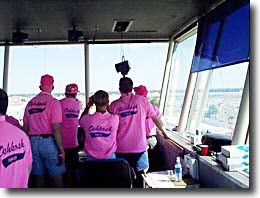 Youhave heard them in your headphones or on the scanner or on AVweb’s live RealAudiofeed. Those men and women who work with pilots to funnel more airplanes into WittmanRegional Airport at Oshkosh, Wisconsin for EAA’s AirVenture than fly into any otherairport in the world at any time are a fascinating set of human beings there up in thetower, in the eye of the tiger. They do an incredible job of sorting out the most diversemix of airplanes found at any airport, anywhere, anytime, and do so with remarkable goodhumor.
Youhave heard them in your headphones or on the scanner or on AVweb’s live RealAudiofeed. Those men and women who work with pilots to funnel more airplanes into WittmanRegional Airport at Oshkosh, Wisconsin for EAA’s AirVenture than fly into any otherairport in the world at any time are a fascinating set of human beings there up in thetower, in the eye of the tiger. They do an incredible job of sorting out the most diversemix of airplanes found at any airport, anywhere, anytime, and do so with remarkable goodhumor.
If you have ever heard the controllers at EAA Oshkosh you know that they manage tocoordinate the arrivals and departures of two to three airplanes per minute,airplanes, for the most part, being flown by pilots who fly for pleasure, not for aliving. The controllers work with the men and women in the airplanes, a few seconds foreach airplane, to create an atmosphere of teamwork and trust in an environment rife withpotential risk. They coax and cajole the overly cautious pilot to fly down the runway twothousand feet before touching down to allow another airplane to land behind him, they sortout the pilot who gets left and right confused and they seem to rapidly evaluate theability of a pilot and issue a clearance to that pilot which will not exceed his abilityto handle. They do this day in and out for the entire AirVenture. They praise and prod,they offer compliments to pilots who do a good job, and many do, and they deal firmly butpolitely with the guys who do remarkably boneheaded things. This is not New York Center.
Preparation
It all starts to come together for the controllers for the annual EAA convention inOctober of each year. Within the Great Lakes region, bids are put out by controllers whowant to work the AirVenture. In November supervisors at the individual tower facilitieslook at the qualifications of the bidders, the seniority of the bidders and makerecommendations as to whom from their tower should be given a recommendation to go play inthe biggest league of all, Oshkosh during the convention. "Put me in, Coach, I’mready."
The next step is for the individual facility managers to look at how many controllersthey can release to OSH without using overtime for the remaining controllers. This tendsto be the limiting factor.
Last year there were 168 bidders. Twelve teams of four controllers were formed aroundthe first of this year, so 48 got the phone call with the "you made it, kid." Ina nutshell, allowing for some controllers who did not get selected because of staffingneeds at home towers, EAA AirVenture Oshkosh gets the best of the best controllers. Itshows.
How It Works
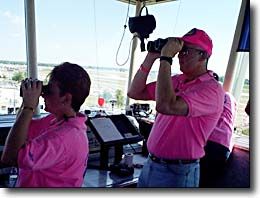 Arthur Hilmer, working ATC quality control at OSH and ordinarily of theMilwaukee control tower spent some time talking to AVweb and explained that thefolks who get to come to OSH and deal with the challenges of the frenzy which ensues are amix of veterans, "limiteds" or those with one previous visit to OSH and rookies.There are six Ops supervisors and an additional nine controllers at the temporary controltower at Fond Du Lac. Appleton controllers continue to handle the influx on their own,generally, but one of the normal OSH controllers goes up to help out. The behind thescenes administration work involved with setting up the tower and mobile towers for EAA ishandled by personnel from Milwaukee and Green Bay.
Arthur Hilmer, working ATC quality control at OSH and ordinarily of theMilwaukee control tower spent some time talking to AVweb and explained that thefolks who get to come to OSH and deal with the challenges of the frenzy which ensues are amix of veterans, "limiteds" or those with one previous visit to OSH and rookies.There are six Ops supervisors and an additional nine controllers at the temporary controltower at Fond Du Lac. Appleton controllers continue to handle the influx on their own,generally, but one of the normal OSH controllers goes up to help out. The behind thescenes administration work involved with setting up the tower and mobile towers for EAA ishandled by personnel from Milwaukee and Green Bay.
Oshkosh tower is a contract tower, with non-FAA controllers, who, however, go throughthe same training as FAA controllers, so they stay on the job and fill in along with thecontrollers from other facilities.
Each team of four controllers will work each possible spot at least once during theconvention. This means the mobile unit outside the town of Fisk, Wisconsin, handling theRipon arrival. At Oshkosh it is north local, south local, ground, clearance, fly-by anditinerant. Fly-by and itinerant operate out of mobile control towers, affectionatelyreferred to as Moo Cows. They position as needed to handle the fly-by circuit on runway18-36 and departures on 9-27. After the airshow when there is a mass of departures thefly-by tower repositions and handles departures on 18-36. The folks in the control toweron the local frequencies, the folks we call "tower" on the radio, usually handleonly arrivals. The controllers in the mobile towers also wear radios they can use to talkdirectly with the controllers in the tower.
As one who suffered a four hour delay trying to get an instrument clearance out of OSHin 1982, the addition of a position to the tower for a controller from Chicago Center tocoordinate instrument departures is a stroke of genius.
Who’s The Boss?
The person who is responsible for managing these teams of superior controllers isWilliam Kribble. He talked with AVweb about the entire process and was good enoughto let us spend time in the tower cab watching these folks in action. He explained thatthe teams start working together right after the first of the year. Decisions are made asto whom is to be on the mike when. For each four person team, one person is on the mikewhile the other three act as spotters. To see it in action is to see a well-choreographeddance. Men and women apply body English as they ask a "twin on downwind" to losealtitude and start the base leg right now. Mr. Kribble commented that the controllers havediscussed how they are going to work their positions and that the positive comments andcompliments from the controllers is conscious. They recognize it creates a betterenvironment for everyone. The happy family metaphor is too trite to describe thesituation, it is more a matter of dedicated professionals in the tower working withdedicated, devoted pilots in a way to bring out the best in both groups of people. Itseems to work. The controllers were able to count the incidents thus far, on the fingersof one hand. Two ground loops, one Cherokee who landed downwind and one guy who landedwhat he called an "ultralight," (which was the size of a Cherokee 140) on runway27 rather than the ultralight runway, after ignoring virtually everyone. When the FAA andEAA talked to him it turned out he had no pilot’s certificate, no driver’s license, he hadbuilt the airplane but had no paperwork on it an simply kept repeating, "it’s anultralight." It left on a truck.
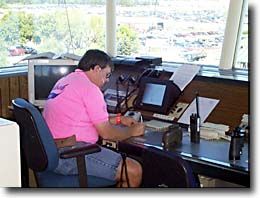 Such few incidents are notenough to affect the positive atmosphere in the tower cab. The local controller is talkingto the arrivals as three spotters assist discreetly. A call is made to a Siai Marchetti todrop its gear. One spots a Mooney on a long final to 27 and the others double check to seeif it is an instrument arrival. It isn’t so a call goes to the Mooney to find out justwhere it came from. A couple of radio calls allow the Mooney to be sequenced onto therunway. The atmosphere is low key and positive. There is some quiet banter between somecontrollers who are experiencing a temporary lull. The Center controller is in the cornerworking to get some IFR departures out without a delay.
Such few incidents are notenough to affect the positive atmosphere in the tower cab. The local controller is talkingto the arrivals as three spotters assist discreetly. A call is made to a Siai Marchetti todrop its gear. One spots a Mooney on a long final to 27 and the others double check to seeif it is an instrument arrival. It isn’t so a call goes to the Mooney to find out justwhere it came from. A couple of radio calls allow the Mooney to be sequenced onto therunway. The atmosphere is low key and positive. There is some quiet banter between somecontrollers who are experiencing a temporary lull. The Center controller is in the cornerworking to get some IFR departures out without a delay.
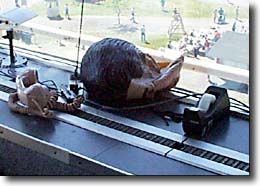 The controllershave an interesting sense of humor, a Ronald Reagan mask lies on a window sill.
The controllershave an interesting sense of humor, a Ronald Reagan mask lies on a window sill.
The Ford Trimotor gives rides off of runway 36, starting its takeoff roll well north ofmidfield, yet each time it lifts off and turns east, well away from the arrivals on runway27. This has been worked out in advance, his presence is a matter of course. He is nottaken for granted, despite the dozens of flights each day, if he wanders off course thecontrollers will take action.
A twin curves around the terminal toward runway 27, setting up perfectly for the greendot painted on the runway as an aiming point. An orange dot is about 1500 feet away,providing another such point so two airplanes can arrive simultaneously. Behind the twin,five yellow homebuilts in formation are sequenced to an in-trail position for landing. Itjust keeps going, and going smoothly. From time to time a pilot messes something up, yetwhile some remarks are made by the spotters, no critical remark escapes the controllerwith the mike. Yep, they do talk about you if you mess up, but, a moment later they areconcentrating on something and someone else.
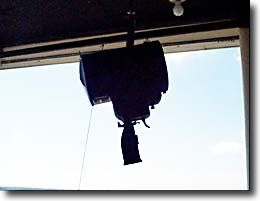 Just before I left I noticed the light signal gun hanging from the ceiling. Itwas covered with dust, but it was still within easy reach should anyone need it.
Just before I left I noticed the light signal gun hanging from the ceiling. Itwas covered with dust, but it was still within easy reach should anyone need it.
As a twin smoothly turns final, two spotters take a brief moment to watch inappreciation and one comments, "that guy knows what he is doing." True enough.By the same token exactly the same comments are being made in dozens of airplanes aboutthe women and men up in that cab.

































